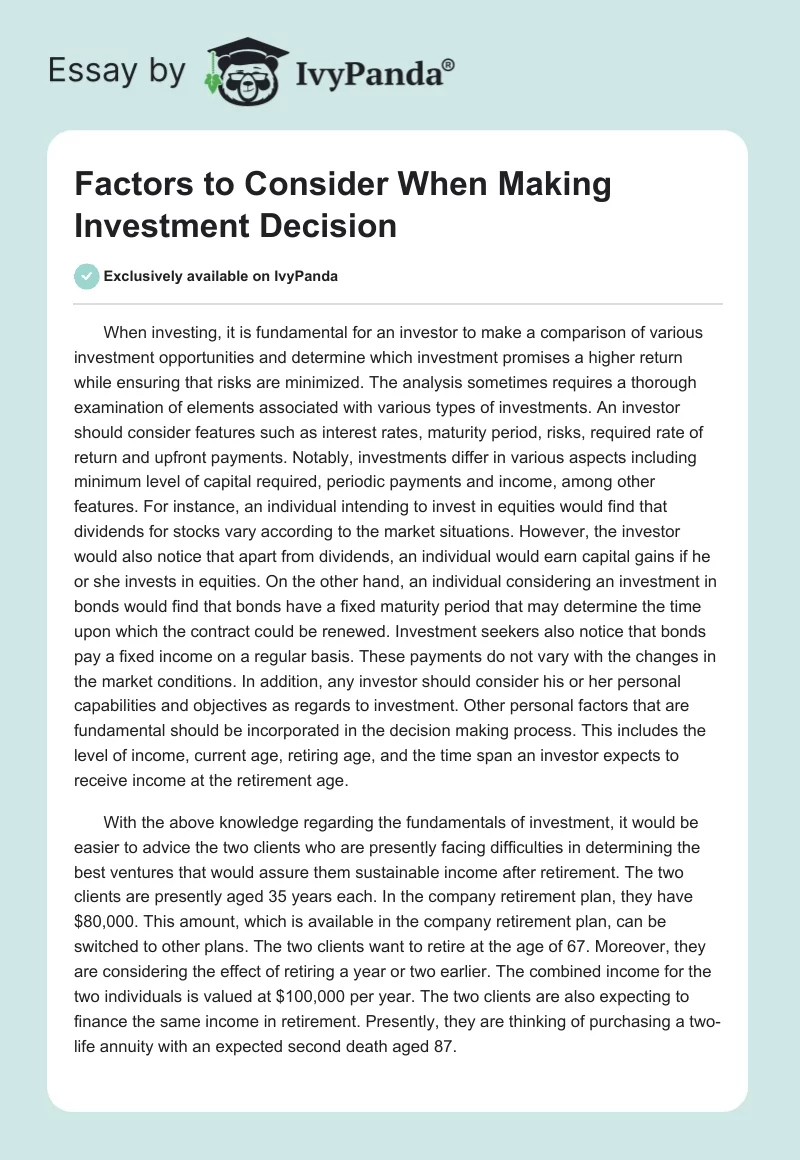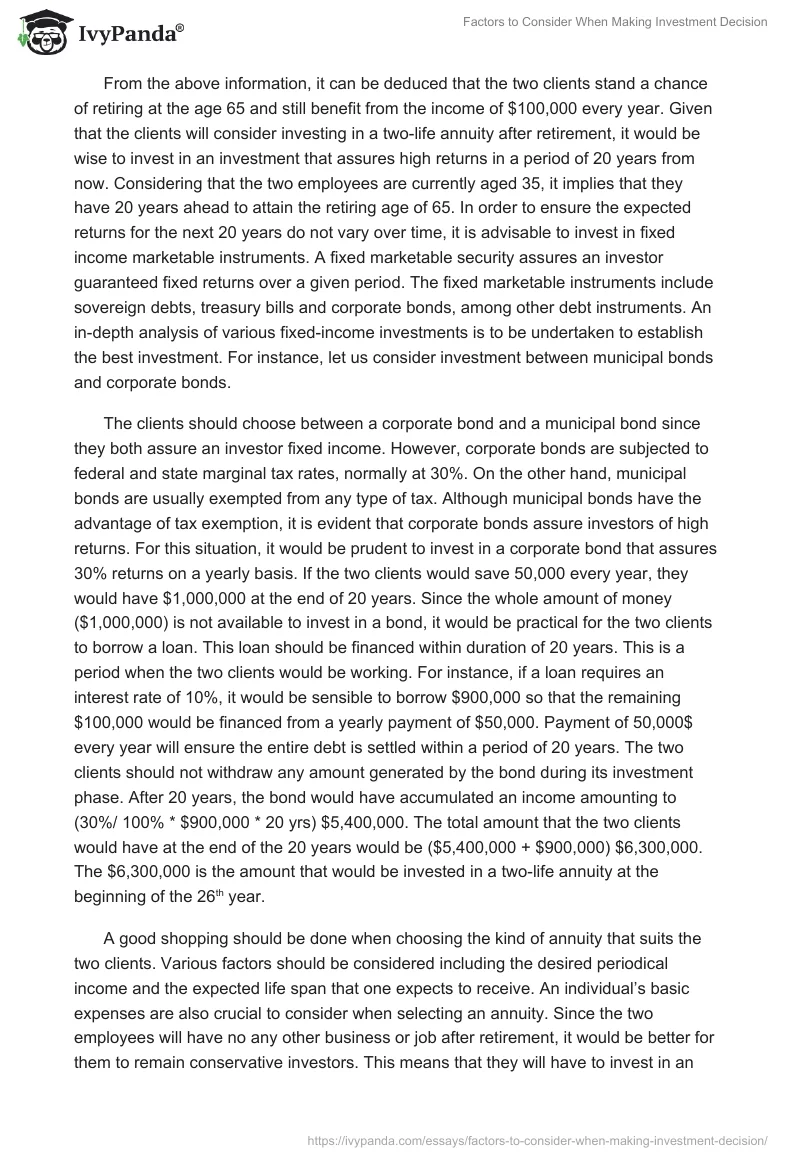When investing, it is fundamental for an investor to make a comparison of various investment opportunities and determine which investment promises a higher return while ensuring that risks are minimized. The analysis sometimes requires a thorough examination of elements associated with various types of investments. An investor should consider features such as interest rates, maturity period, risks, required rate of return, and upfront payments.
Notably, investments differ in various aspects including minimum level of capital required, periodic payments, and income, among other features. For instance, an individual intending to invest in equities would find that dividends for stocks vary according to the market situation. However, the investor would also notice that apart from dividends, an individual would earn capital gains if he or she invested in equities. On the other hand, an individual considering an investment in bonds would find that bonds have a fixed maturity period that may determine the time upon which the contract could be renewed.
Investment seekers also notice that bonds pay a fixed income on a regular basis. These payments do not vary with the changes in the market conditions. In addition, any investor should consider his or her personal capabilities and objectives as regards to investment. Other personal factors that are fundamental should be incorporated in the decision-making process. This includes the level of income, current age, retiring age, and the time span an investor expects to receive income at the retirement age.
With the above knowledge regarding the fundamentals of investment, it would be easier to advise the two clients who are presently facing difficulties in determining the best ventures that would assure them sustainable income after retirement. The two clients are presently aged 35 years each. In the company retirement plan, they have $80,000. This amount, which is available in the company retirement plan, can be switched to other plans. The two clients want to retire at the age of 67. Moreover, they are considering the effect of retiring a year or two earlier. The combined income for the two individuals is valued at $100,000 per year. The two clients are also expecting to finance the same income in retirement. Presently, they are thinking of purchasing a two-life annuity with an expected second death age of 87.
From the above information, it can be deduced that the two clients stand a chance of retiring at the age of 65 and still benefit from the income of $100,000 every year. Given that the clients will consider investing in a two-life annuity after retirement, it would be wise to invest in an investment that assures high returns in a period of 20 years from now. Considering that the two employees are currently aged 35, it implies that they have 20 years ahead to attain the retirement age of 65. In order to ensure the expected returns for the next 20 years do not vary over time, it is advisable to invest in fixed-income marketable instruments. A fixed marketable security assures an investor guaranteed fixed returns over a given period. The fixed marketable instruments include sovereign debts, treasury bills, and corporate bonds, among other debt instruments. An in-depth analysis of various fixed-income investments is to be undertaken to establish the best investment. For instance, let us consider investment between municipal bonds and corporate bonds.
The clients should choose between a corporate bond and a municipal bond since they both assure an investor-fixed income. However, corporate bonds are subjected to federal and state marginal tax rates, normally at 30%. On the other hand, municipal bonds are usually exempted from any type of tax. Although municipal bonds have the advantage of tax exemption, it is evident that corporate bonds assure investors of high returns. For this situation, it would be prudent to invest in a corporate bond that assures 30% returns on a yearly basis.
If the two clients would save 50,000 every year, they would have $1,000,000 at the end of 20 years. Since the whole amount of money ($1,000,000) is not available to invest in a bond, it would be practical for the two clients to borrow a loan. This loan should be financed within duration of 20 years. This is a period when the two clients would be working. For instance, if a loan requires an interest rate of 10%, it would be sensible to borrow $900,000 so that the remaining $100,000 would be financed from a yearly payment of $50,000. Payment of 50,000$ every year will ensure the entire debt is settled within a period of 20 years. The two clients should not withdraw any amount generated by the bond during its investment phase. After 20 years, the bond would have accumulated an income amounting to (30%/ 100% * $900,000 * 20 yrs) $5,400,000. The total amount that the two clients would have at the end of the 20 years would be ($5,400,000 + $900,000) $6,300,000. The $6,300,000 is the amount that would be invested in a two-life annuity at the beginning of the 26th year.
A good shopping should be done when choosing the kind of annuity that suits the two clients. Various factors should be considered including the desired periodical income and the expected life span that one expects to receive. An individual’s basic expenses are also crucial to consider when selecting an annuity. Since the two employees will have no any other business or job after retirement, it would be better for them to remain conservative investors. This means that they will have to invest in an annuity that has low level of risk. Investments that have low levels of risk are associated with low levels of returns. In this regard, the two clients should avoid purchasing a variable annuity and instead choose a fixed-income annuity.
The underlying assets of variable annuity include shares, whose incomes vary with the market conditions. It would also be more sensible to pay an upfront premium of $6,300,000 at the beginning of the 26th year. In this case, it would be desirable to choose an insurance company that pays a fixed rate of 5% every year for duration of 20 years. At age 65, the two clients will live 20 years to attain 85 years, which is an age they expect to stop receiving the income. At the rate of 5%, it would mean that the two employees would earn a total of $300,000 every year. The two clients would expect to receive this amount at the beginning of the payout phase, which is anticipated to begin in the 26th year. It can be deduced that each individual would receive an income of $150,000 every year for a period of 20 years. At this stage, it is assumed that the insurance company charges a fee of $15,000 every year for administrative and other activities. This amount is thrice the amount that was initially demanded by the clients of $100,000 every year.


